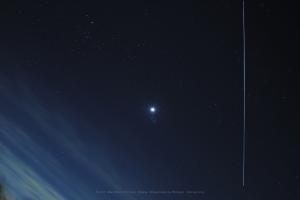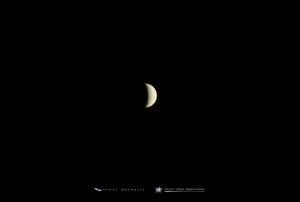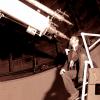Celebration of Space - June 2, 2023
This coming Saturday, June 3, 2023, at 11:44 pm, the Moon will once again orbit into a position where it is on the opposite side of Earth than the Sun. Astronomers call this opposition, but everyone else calls it the Full Moon. During the full Moon, the side of the Moon that faces Earth will be in direct sunlight, with the opposite side of the Moon experiencing full darkness. After the full Moon occurs, the waning intermediate phases kick in, eventually bringing back those super dark post twilight sessions.
The June full Moon is often referred to as the Full Strawberry Moon. Which fits well for June, because it’s the time to pick strawberries. Though another name that comes to mind, for the June Moon, is the Full Honey Moon, which has to do with the color of the Moon in June. The full Moon closest to the Summer Solstice, will have the deepest hues of golden yellow. This happens because of the Moon’s inclination to its orbit. Unlike most moons, which sit around the equator of their parent object, Earth’s moon is inclined 5.1º to the ecliptic, which is the path the Sun takes across the sky. As a result, the full Moon will always follow nearly the same path across the sky as the Sun will in six months time. In June, the Sun will cross the sky at 23.4º above the celestial equator, which is the highest for the year. Consequently, the Moon will cross the sky in between 18.3º – 28.5º below the celestial equator. When the Moon is this low in the sky, we see it through a lot more atmosphere than we would when it is closer to the zenith (top of the sky). The additional atmosphere that moonlight has to pass through causes the blue wavelengths to scatter, giving the Moon a ruddier hue. But if there is a lot of wildfire smoke in the atmosphere, like there has been this year, then the green wavelengths can scatter too, giving us a rather red Moon. If that happens, then we will have the Strawberry Moon that everybody would love to see – red like a strawberry. So get outside tomorrow night, perhaps while snacking on a strawberry, and see if you can spot the Strawberry Moon. The best time for colors will be during Moon rise.
Tonight, June 2, 2023, Mars will visibly pass through the Messier 44 open star cluster, commonly referred to as the Beehive Cluster. In reality, Mars is only 16.7 light minutes distant from Earth, with the Beehive Cluster residing at 577 light years distant. So this is a conjunction, but it is a rather uncommon conjunction. The conjunction actually started on June 1st, but June 2nd is the better night to observe. Even June 3rd will offer a good view. To observe the conjunction, you will need either binoculars or a telescope. With the Moon being so close to its full phase, the Beehive Cluster will not be visible to the naked eye, though Mars is visible to the naked eye, making it easy to find. Waiting until the end of twilight, around 9:30 pm, will offer the best view, and the cluster is rather large, making it easy to see. Check out our finder chart.
Earlier today, at 12:00 pm, the European Space Agency (ESA) hosted the first ever live stream from Mars. The images were provided by the ESA Mars Express orbiter, which is in orbit around Mars. Even though the view was live, it takes 16 minutes for the live stream to reach Earth. The live stream event was held in celebration of the Mars Express 20th birthday. Even though the live stream completed at 1:00 pm, the archived stream is available for viewing. Way to go ESA!
Over the past several months, Venus has been rising higher and higher in the western sky after sunset, as well as growing brighter. Venus reaches Maximum Eastern Elongation on Sunday, June 4, 2023, which is when Venus and Earth reach the point in their orbits when the tangential angle, when viewed from Earth, forms a right angle with the Sun. Think of a triangle consisting of a straight line starting at Earth and ending at an inner planet, then another line from the inner planet (inferior) to the Sun, and a third line extending from the Sun to Earth. When the line from Earth to the inner planet and the line from the inner planet to the Sun form a right angle (90°), you have maximum elongation of the inner planet. Consequently, when the line from Earth to an outer (superior) planet and the line from the Sun to Earth form a right angle, you have Quadrature of the outer planet. Eastern elongation means that the inner planet is at maximum elongation while being placed on the eastern side of the sky in relation to the Sun. Starting on Monday, June 5th, Venus will move into its waning crescent phase, and will continue to wane until it reaches Inferior Conjunction on August 13, 2023, which is when Venus arrives in between Earth and the Sun. Though Venus will continue to wane well into a super thin crescent phase, it will continue to increase in apparent brightness because it is moving closer to us with each passing day. If you have a backyard telescope or high power binoculars, step outside each night over the next few months and catch a view of Venus in the western sky after sunset and notice the rate at which it wanes. In any case, we will be showing it regularly at Frosty Drew Observatory.
- Author:
- Scott MacNeill
- Entry Date:
- Jun 2, 2023
- Published Under:
- Scott MacNeill's Columns




